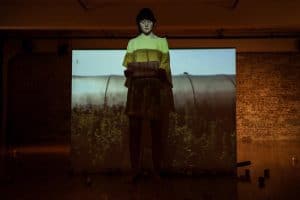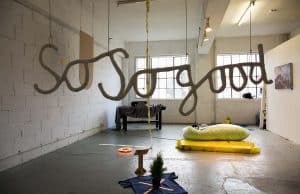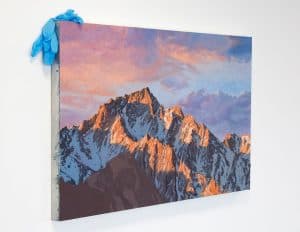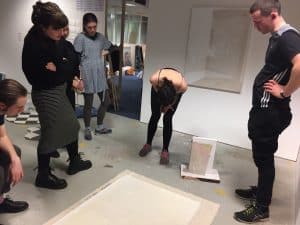Graduation day dawns for a new generation of budding artists… with the combined sense of liberation and danger familiar to all who have undergone a lengthy duration in a full time course, or a full time job. After three years of comfortable-intense-claustrophobic domesticity down on the art school farm (as one among a nurtured herd of contented beasts, one sincerely hopes, not one among many miserable, factory-farmed, hormone-riddled near-carcasses), on this fine morn the farm gate is flung open and you are pushed out, gripping your 2:1 (other results are available) in your sweaty and shaking fist, into, well, into what? Into the Wild?
 Picture a forest, resplendent in parts with grand oaks and beeches. In other areas, lower level trees like birches dominate, these are attractive but short-lived. On the margins are scrubby areas that are prone to bog and grazing. In the high forest the trees are awe-inspiring, but the understory is dark and deserted. Only a few favored saplings are nurtured. Among the stands of beech trees, dry leaves rustle underfoot and visitors traverse freely underneath, kicking up leaves. Ground flora is minimal because beech roots exude a toxic sap to protect their territory.
Picture a forest, resplendent in parts with grand oaks and beeches. In other areas, lower level trees like birches dominate, these are attractive but short-lived. On the margins are scrubby areas that are prone to bog and grazing. In the high forest the trees are awe-inspiring, but the understory is dark and deserted. Only a few favored saplings are nurtured. Among the stands of beech trees, dry leaves rustle underfoot and visitors traverse freely underneath, kicking up leaves. Ground flora is minimal because beech roots exude a toxic sap to protect their territory.
The generous spread of the oak tree is worth noting, it supports more biodiversity than any other tree in Britain. The practical-minded, networked, and internship-ped among art graduates seek out a living as gallery techs, artists’ assistants, art administrators, educators. Others just gather acorns and nibble lichen along with the squirrels, or work in bars. Still others resign themselves to continuing the sex work that paid their way through Uni.
For many artists, nothing that a degree course could offer would make the transition to the ‘real world’ a smooth one. Staff  must use their time and resources to concentrate on what happens within the institution, and students are necessarily focused on two major events – degree show and dissertation. As the luxury of time in the studio abruptly evaporates, so too does a less visible but still profound support structure. At art school, it is easy to justify pursuing the ‘making’ of art (whatever processes that may entail) because that is the contextual demand. Out in the wilds no such expectation-reason-justification is incoming, and nascent artists can fall at the first hurdle, that of creating a self-demanding, critical yet fulfilling relationship to their work. Let’s face it, choosing to pursue life as an artist is a weird and nebulous path at the best of times, let alone now.
must use their time and resources to concentrate on what happens within the institution, and students are necessarily focused on two major events – degree show and dissertation. As the luxury of time in the studio abruptly evaporates, so too does a less visible but still profound support structure. At art school, it is easy to justify pursuing the ‘making’ of art (whatever processes that may entail) because that is the contextual demand. Out in the wilds no such expectation-reason-justification is incoming, and nascent artists can fall at the first hurdle, that of creating a self-demanding, critical yet fulfilling relationship to their work. Let’s face it, choosing to pursue life as an artist is a weird and nebulous path at the best of times, let alone now.
When graduates spill out into an art world bursting with plump fruits that are out of reach to all but a few, it helps to create a powerful sense of failure in everyone else. The challenges are financial and practical, but they are also emotional. At pivotal moments, as when your degree course ends, the recognition that your struggles are not unique can be invaluable. All artists need to build independent support structures, and one cannot overestimate the value of contact with, or making friends with, others in similar circumstances.
Into the Wild supports fourteen recent graduates over a year, with a programme of invited speakers, crits, and skill sharing, plus supported opportunities to make and show work together. Into the Wild achieves a lot in acknowledging and engaging, but also circumnavigating establishment structures and dominant hierarchies, concentrating instead on exploring the diverse activities and ecologies of art, and nurturing pertinent contexts, with a do-it-yourself ethos.

An artist’s ‘success’ inside this budding reciprocal network is redefined away from something conferred to the few by the very few, towards a continual process that is negotiated and claimed, created and defined through the doing of things, and the extended conversation (using words, actions and things) between those who act and think within art’s labile structures. ‘Wildies’, as alumni and participants are affectionately known, credit the programme with displaying and supporting their individual and communal efforts to find a path into working as an artist, and with building the confidence and knowledge to initiate their own artistic and curatorial structures.
The mood of meetings is intentionally informal, encouraging speakers and participants alike to be truthful and vulnerable, to nurture a space in which it is possible to discuss the sometimes harsh realities of sustaining an artistic practice. That speakers are encouraged to give “very real and practical advice,” which is “free of any pretence” stems from the honest, myth-busting ethos of the programme’s founders, Chisenhale Studios artists, who understood from the inside the difficulties in establishing and sustaining an art practice in London; from programme leader Louise Ashcroft and Exec Director, Andrea Davidson.
 Louise, as a dropout from the Royal College of Art and founding member of alternative education programme AltMFA, has strong opinions about humour and truth. Her art practice is a wild-ebeest of incisive wit and inventive joy that rampages through the malls, supermarkets, politics and screens of advanced capitalist culture. As her practice pirouettes between genres and media, so Into the Wild offers a diverse platform on which to debate what it is to be an artist, what artists want artists to be, and how you might achieve a place to survive and thrive within that.
Louise, as a dropout from the Royal College of Art and founding member of alternative education programme AltMFA, has strong opinions about humour and truth. Her art practice is a wild-ebeest of incisive wit and inventive joy that rampages through the malls, supermarkets, politics and screens of advanced capitalist culture. As her practice pirouettes between genres and media, so Into the Wild offers a diverse platform on which to debate what it is to be an artist, what artists want artists to be, and how you might achieve a place to survive and thrive within that.
In the forest, inter-tree competition for sunlight is balanced by an underground sharing of resources. A web formed of fungal mycelia connects tree to tree, across many species, absorbing and storing nutrients, which they redistribute around the forest. All fungi have mycelia, but only some form mycorrhizal associations with vascular plants like trees or grasses. The hyphae either penetrate inside the root, or cluster around the root tips. They act like a vast underground storeroom and transport system, feeding the trees minerals they can’t access alone, and receiving photosynthesised sugars in return.
The mycorrhizal network has become known as the wood-wide-web, an organic internet, because it also acts as a vast underground communication network – mycelia are super-sensitive to their immediate environment, and electro-chemically send this information around the landscape. Usually, relationships of exchange in mycorrhizal networks are reciprocally balanced. If a plant ceases to provide sugar, the fungi will reduce the minerals they give. But the network also responds to need, sending nutrients to sick trees, for example, or helping trees to feed their shaded children.
Into the Wild delineates spaces for creative cooperation and non-competition. It builds recognition of the need for give and  take, ambition and collectivity. A requirement to agree on elements to the programme’s own structure and opportunities for collaboration on projects builds sustainable, self-reliant modes of operation that can serve artists well for the future. Within the context of Chisenhale Studio’s supportive platform, participants can initiate targeted connections with art world professionals, and ask individuals to lead workshops and crit sessions. Sometimes, a conversation gets dominated by powerful, critical individuals (beech trees in the making, perhaps), but most cohorts generate and sustain mutually supportive, reciprocal networks that bring professional and personal outcomes for all participants. Each year-group has a significant influence on how the programme develops, which means it is reborn each year, like a perennial plant, nurtured by the rich compost of its predecessors.
take, ambition and collectivity. A requirement to agree on elements to the programme’s own structure and opportunities for collaboration on projects builds sustainable, self-reliant modes of operation that can serve artists well for the future. Within the context of Chisenhale Studio’s supportive platform, participants can initiate targeted connections with art world professionals, and ask individuals to lead workshops and crit sessions. Sometimes, a conversation gets dominated by powerful, critical individuals (beech trees in the making, perhaps), but most cohorts generate and sustain mutually supportive, reciprocal networks that bring professional and personal outcomes for all participants. Each year-group has a significant influence on how the programme develops, which means it is reborn each year, like a perennial plant, nurtured by the rich compost of its predecessors.
Adapted from original article written by Fiona MacDonald:Feral Practice which can be found here: Artist of the Wild, Unite!
Fiona MacDonald is an artist, curator and researcher responding to other species, places, and ecologies. She works with humans and nonhumans as Feral Practice to create art programmes and projects that explore and challenge human-nonhuman relationship, and nurture artists’ and young people’s development.
Thanks to Into the Wild alumni for their interview contributions. Commissioned by Chisenhale Studios. 2018
Images (in order)
Hazel Dowling performance Chisenhale Open Weekend 2015 (photo by Manu Valcare)
The Fear is Back group show 2017 (photo by Vanek Photography).
Oliver Durcan, The Painter and Their Desktop 2017 (photo by the artist)
Into the Wild group show, 2018
Group crit, 2017(photo by Oliver Durcan)
